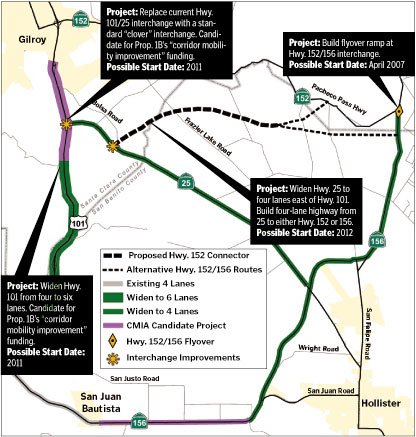Hollister
– A pair of transportation projects near Gilroy could become the
first stage in an ambitious $500 million plan to build an east-west
highway between the south Bay Area and the Central Valley.
By Anthony Ha Staff Writer
Hollister – A pair of transportation projects near Gilroy could become the first stage in an ambitious $500 million plan to build an east-west highway between the south Bay Area and the Central Valley.
Though officials have yet to mark their maps with a solid line showing the new route, they are better positioned than ever to push forward on the project, according to Gilroy City Councilman Roland Velasco.
“What you are seeing is significant synergy between the city of Gilroy, San Benito County and Santa Clara County,” he said. “Everybody seems to have this willingness to try to make something happen. And that’s different than in past.”
In a matter of months, construction will begin on a flyover at the intersection of Highways 152 and 156, a crossroads east of Gilroy that routinely backs up traffic for miles on weekends and holidays. And at the end of February, local officials hope to hear good news from the state on a request for $108 million, earmarked for improvements to U.S. 101 and its interchange with state Route 25, just south of Gilroy.
Public officials are now dogged by the question of what should go between the flyover and the new interchange. Officials in San Benito and Santa Clara counties agree on the need for an eight-mile, east-west, four-lane road south of Pacheco Pass Highway. They agree it should connect U.S. 101 with either highways 152 or 156. But they don’t know where to draw the line on a map.
“At this point, it’s just a dashed line,” said Lisa Rheinheimer, new executive director for San Benito County Council of Governments (COG), the county’s transportation agency. Plans are “all conceptual” and could change dramatically, she said.
On blueprints drawn up by the Santa Clara County’s Valley Transportation Authority, the bypass runs through both San Benito and Santa Clara counties – a possibility that rankles some San Benito residents who fear hundreds of millions of dollars in new tax burdens.
Widening Highway 152 has been proposed as a solution to shift work – and costs – north of the San Benito County border, but the idea could prove prohibitively expensive due to hilly terrain, Rheinheimer said.
VTA hopes to obtain state funds in March to conduct a more careful study of the costs and feasibility of different routes.
Rheinheimer said the bypass is also in line with the county government’s long-term plan of widening highways 152, 156 and 25.
“We need to get that traffic moving across the hill in the safest manner,” said Hollister Mayor Brad Pike, whose top priority is fixing Highway 152.
Officials also know what they don’t want.
In the past, some locals – notably members of the San Benito County Farm Bureau – have pushed for a “three-in-one” highway that would largely replace the region’s other routes. Greg Swett, chairman of the farm bureau’s transportation committee, has said the three-in-one would be safer and more financially feasible than improving each individual highway.
However, Rheinheimer said each of the three highways serves a unique need, and that they could not be effectively replaced by just one route.
“The numbers don’t support people actually using it,” she said.
Rheinheimer acknowledged that getting money to improve all three highways is a challenge. Rather than getting all the funding at once, COG and VTA will have to “phase things in useful chunks.”
But she said it’s still more likely than getting the dollars and political support for a three-in-one.
Construction of the $33-million flyover is set to begin in April. If officials pull down $108 million for the U.S. 101 and Route 25 improvements, construction must begin on the project by 2012. Though statewide applications far outstrip the $4.5 billion earmarked for this round of funding, local officials have expressed confidence in their ability to pull down the money.
If all goes according to plan, the Pacheco Pass bypass should take much of the truck and commuter traffic off surrounding highways, becoming the major route connecting the south Bay Area and Interstate 5.















